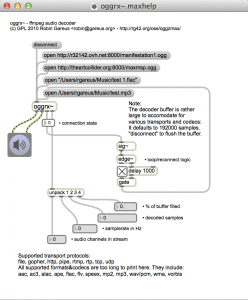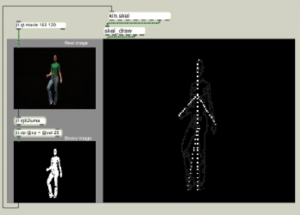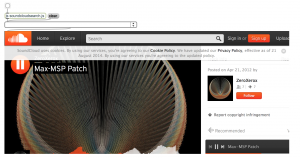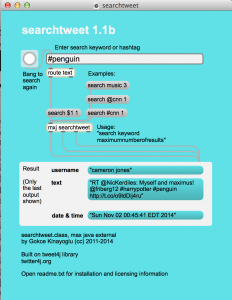Programming interactive audio software and plugins in Max/MSP
Spring 2015
teacher: Tom Zicarelli – http://tomzicarelli.com
You can reach me at: [email protected]
Office hours: Tuesday 1-2 PM, or Tuesday 4-5PM, at the EPD office #401 at 161 Mass Ave. Please email or call ahead.
Assignments and class notes will be posted to this blog: https://reactivemusic.net before or after the class. Search for: ep-341 to find the notes
Examples, software, links, and references demonstrated in class are available for you to use. If there is something missing from the notes, please ask about it. This is your textbook.
Syllabus:
Prototyping is the focus. Max is a seed that has grown into music, art, discoveries, products, and entire businesses.
After you take the course, you will have developed several projects. You might design a musical instrument or a plugin. You will have opportunities to solve problems. But mostly you will have a sense of how to explore possibilities by building prototypes in Max. You will have the basic skills to quickly make software to connect things, and answer questions like, “Is it possible to make something that does x?”.
You will become familiar with how other artists use Max to make things. You will be exposed to to a world of possibilities – which you may embrace or reject.
We will explore a range of methods and have opportunities to use them in projects. We’ll look at examples by artists – asking the question: How does this work?
Success depends on execution as well as good ideas.
Topics: (subject to change)
- Max
- Reverse engineering
- Transforming and scaling data
- Designing user interfaces
- Messages and communication, MIDI/OSC
- randomness and probability
- Connecting hardware and other devices
- Working with sensors, data, and API’s
- Audio signal processing and synthesis.
- Problem solving, prototyping, portfolios.
- plugins, Max for Live.
- Basic video processing and visualization
- Alternative tools: Pd
- Max externals
- How to get ideas
- Computers and Live performance
- Transcoding
Grading and projects:
Grades will be assigned projects, several small assignments/quizzes, and class participation. Please see Neil Leonard’s EP-341 syllabus for details. I encourage and will give credit for: collaboration with other students, outside projects, performances, independent projects, and anything else that will encourage your growth and success.
I am open to alternative projects. For example, if you want to use this course as an opportunity to develop a larger project or continue a work in progress.
Reference material
https://cycling74.com/wiki/index.php?title=Max_Documentation_and_Resources




